Who doesn’t like a nice big plate of French Toast? For me it brings back fond childhood memories of Saturday mornings — usually during the holidays when no one seemed to be in a hurry to change out of our pj’s to go anywhere. Truly, French toast a quintessential breakfast food, though I’ll eat it for any meal if given a chance — especially if it’s served with real maple syrup, a dab of melting butter, and maybe some fresh fruit or berries on the side.
But did you know that this delectable dish we call French Toast has been around for over a thousand years? And it wasn’t always breakfast fare, in fact, it likely started out as a dessert.
The earliest documented recipe for French toast can be found in the Apicius — a collection of 4th and 5th century Roman recipes. The dish is simply titled, “Another Sweet.” Its translation reads:
“Break a slice of fine white bread, crust removed, into rather large pieces. Soak in milk and beaten eggs, Fry in oil, cover in honey, and serve.”
Bread was known as the staff of life. It was the dietary pillar of cultures around the world. But what was one to do when their bread went stale?
In an old nameless English cookbook from 1430, later compiled and published under the name “Two 15th Century Cookery Books,” We find a recipe for bread dipped in egg yolks, fried in butter, and sprinkled with sugar.
The name of this dish is the French word, “Payn Perdeuz,” meaning “Lost Bread” or “Wasted Bread,” suggesting the recipe was intended for bread that had gone stale. This name seemed to stick for many years in the vocabulary of English cooks.
Karen Hess, who transcribed Martha Washington’s Book of Cookery, says,
“The English early took to pain perdu and made it their own; it was rarely omitted from a cookbook, usually listed under “made dishes”…or any dish that amused the cook or showed off her skill.”
Here is our take on an 18th-century recipe for Payn Perdue:
Ingredients:
1 – Medium loaf of firm enriched bread. (The No-Knead “French” Bread in our most recent video would make a perfect choice. If you’re not up to making your own bread, Challah, Brioche, or a Country French loaf will work perfectly. Stale bread is better. You can leave it out overnight if you need to, out of reach of the critters)
8 – Egg yolks
1 Cup of Cream
1/4 Cup Sweet Sherry
1-1/2 Tablespoons Sugar
1/2 teaspoon Grated Nutmeg
3 – 4 Tablespoons Butter
For the sweet sauce (instead of maple syrup)
4 Tablespoons Butter, Melted
1-1/2 Tablespoon Sugar
2 Tablespoons Sweet Sherry
Instructions:
Take a sharp or serrated knife and slice off all the outer crust of the bread. Cut the remaining crumb into slices about 3/4″ thick.
In a bowl, mix the egg yolks, cream, sherry, and sugar. Season with grated nutmeg.
Dip the bread slices in the egg mixture, making sure you get the edges as well, and set them on a plate for a while — 15 minutes should do, unless your bread is really stale, then it might take longer.
While the bread slices are sitting there soaking up the egg mixture, go ahead and mix the melted butter, sherry and sugar for the sweet sauce. Set this nearby for serving your toasts.
Melt 3 to 4 tablespoons of butter in a large skillet over medium heat. You may have to be very careful handling the bread at this point, depending on the type of bread that you use. When your butter has stopped bubbling and it’s quieted down just a bit, fry your payn perdue slices on both sides until they are a golden brown.
Pour the sweet sauce over your slices and serve.
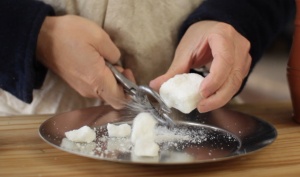
Refined white sugar in the 18th century came in cone-shaped cakes, wrapped in blue paper. Sugar Nippers were often employed to break it apart.
For authentic alternatives to our 18th century sweet sauce, you can also use honey, light molasses, maple syrup, or you can simply sprinkle it with sugar and a bit of ground cinnamon.
A sweet and sour alternative that is likewise very authentic, would substitute verjus for the sherry. Verjus is the unfermented juice of unripe grapes. It was commonly used in the 18th century for pickling and spicing up sauces in place of vinegar. It’s available online.

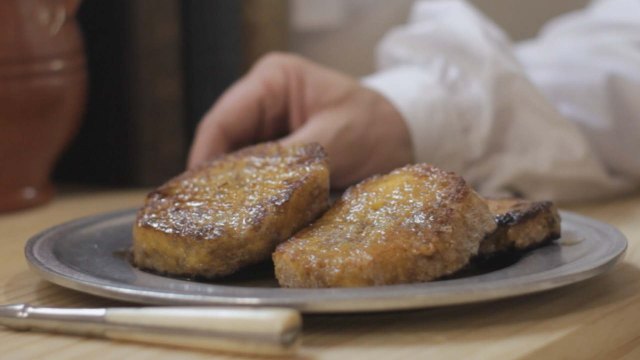

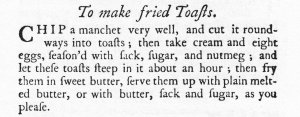
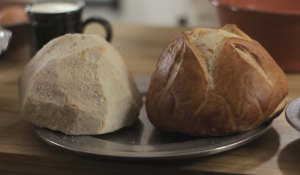
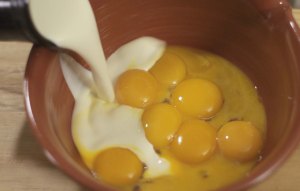
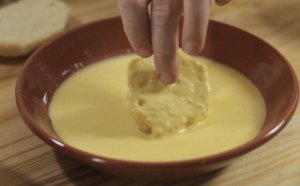
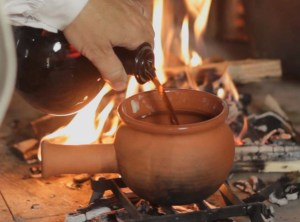
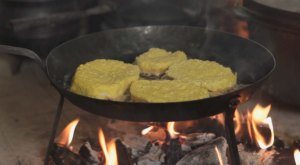

I cooked this recipe this morning and let me tell you the only reason to return to French toast the “regular” is when I can’t cook anymore!!! Absolutely wonderful!!! I’ve tried much of the food recipes on your channel and I have come to the realization that i am just going to start cooking this way all the time!!! My modern food and recipes are starting to taste bland and just not exciting anymore. Thank you so much for posting these!!!! I very much look forward to the next segment of 18th century cooking!!!
Pingback: HFF: Pan Perdu for Breakfast | Mug & Key